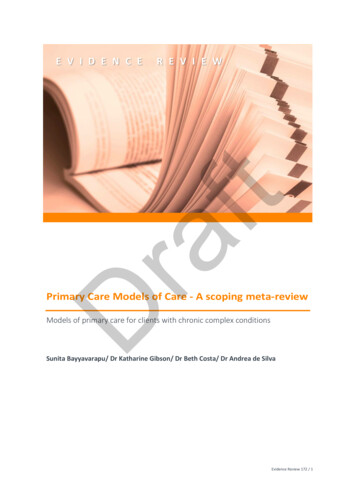
Transcription
R E V I E WraftE V I D E N C EDPrimary Care Models of Care - A scoping meta-reviewModels of primary care for clients with chronic complex conditionsSunita Bayyavarapu/ Dr Katharine Gibson/ Dr Beth Costa/ Dr Andrea de SilvaEvidence Review 172 / 1
CONTENTSCONTENTS2LIST OF TABLES3LIST OF FIGURES3ACKNOWLEDGEMENTS4LIST OF ABBREVIATIONS5EXECUTIVE SUMMARY6Background and PurposeMethodKey FindingsKey InsightsraftINTRODUCTIONResearch questions and scopeMETHODSLiterature search1. Primary care-based models2. Systematic reviews of primary care interventionsStudy review processQuality AppraisalSynthesis of primary health intervention dataRESULTS666788999910101011Primary health modelsAustralian Primary care modelsChronic Care Model1111122.CCM-based primary care interventionsCharacteristics of systematic reviewsEvidence of the effectiveness of chronic care model elements131315D1.LimitationsIMPLICATIONS OF THE FINDINGS17181.Primary care modelsKey considerations18182.Primary care interventionsKey considerations1819CONCLUSION19REFERENCES20Evidence Review 172 / 2
APPENDICES22Appendix 1: PRISMA flowchart of Stage 2Appendix 2: Systematic review characteristicsAppendix 3: Systematic review findings222325LIST OF TABLESTable 1. Description of the eight Chronic Care Model elements16, 23, 2413Table 2. Chronic Care Model elements in single and multi-element interventions14Table 3. Example interventions evaluated across primary studies according to Collaborative CareModel elements15raftLIST OF FIGURES1112DFig 1. The HealthCare Home Model3Fig 2. Example of use of collaborative chronic care model for mental health in primary care,23based on original Wagner Chronic Care Model.16Evidence Review 172 / 3
ACKNOWLEDGEMENTSDraftThis report has been prepared for the Transport Accident Commission (TAC). The Institute of Safety,Compensation and Recovery Research (ISCRR) would like to acknowledge the TAC and members ofthe Health Working group for their assistance and collaboration throughout the development of thisevidence review. The authors also wish to thank staff at ISCRR who supported the evidence reviewand production of the report.Evidence Review 172 / 4
LIST OF ABBREVIATIONSFull formAssessing the Methodological Quality of Systematic ReviewsCollaborative Care Model/Collaborative Chronic Care ModelInstitute for Safety Compensation and Recovery ResearchModel of Care/Models of CareMusculoskeletalPrimary Health CareRandomised controlled trialTransport Accident CommissionWorld Health HCRCTTACWHOEvidence Review 172 / 5
EXECUTIVE SUMMARYBackground and PurposeIn Australia, primary care is generally provided by general practitioners, nurses (including generalpractice nurses, community nurses and nurse practitioners), allied health professionals, midwives,pharmacists, dentists, and Aboriginal health workers. Complex health conditions are often managedin primary health care settings and require intense case management, coordination and frequentcontact.This evidence review was conducted to identify primary care models and interventions that areeffective at supporting individuals with chronic and complex ongoing health conditions. Additionallywe sought to identify the specific elements of the effective primary care models and interventions inorder to determine what works and how it might work. It is intended that the findings from thisevidence review will provide evidence of effective primary care models and interventions availableto the Transport Accident Commission (TAC) to inform the development of their new Primary HealthCare strategy.raftMethodThis evidence review is in the form of a scoping meta-review and has two parts: 1) a search formodels of primary care and associated interventions (through a search of published studies andonline databases); and 2) a search for systematic reviews of effectiveness studies from within thepart 1 search results, and additional targeted scanning.Key FindingsDInitially we identified two comprehensive models of primary care. The Health Care Home model which was developed recently in Australia, and the collaborative Chronic Care Model (CCM) originally developed in the USA in the 1990s. To examine the effectiveness of these models onpatient outcomes we focused solely on the CCM. The CCM is comprised of eight elements. Ninesystematic reviews were identified that evaluated primary care interventions based on the CCM. Theindividual interventions within the systematic reviews were examined and characterised accordingto the specific CCM elements they tested.The key findings are summarised below: Overall, the collaborative Chronic Care Model appears to be effective across differentdisorders and populations for physical health conditions, mental health andcomorbidities.There is good evidence of the effectiveness of primary care interventionsincorporating the following four elements of the Chronic Care Model: Selfmanagement support, delivery system design, decision support, and clinicalinformation systems.Evidence for the effectiveness of including the health system improvement,community support, and family support elements of the Chronic Care Model iscurrently lacking, which means we do not yet know if these interventions areeffective.Multiple element interventions were found to be generally more effective, howeverthe effectiveness of interventions which included all eight elements of the ChronicCare Model has not been sufficiently evaluated.Evidence Review 172 / 6
Single element interventions, such as self-management support and delivery systemdesign, may be as effective as multiple element interventions for some clients ifdelivered at the right intensity.Key InsightsKey considerations and insights emerging from this evidence review are: Draft The Chronic Care Model has a robust evidence base and can be used as a frameworkto guide development of a TAC approach to primary health care.Including two or more elements of the Chronic Care Model is well supported byevidence.Self-management support interventions need to be delivered comprehensively, overtime and in combination with other elements of the Chronic Care Model.Consider delivering Delivery system design, Decision support and Clinical informationsystem interventions in combination, for example multidisciplinary evidence-basedguidelines and case management supported by referral systems and electronic clientrecordsPartnerships and collaboration with health care providers that includes developingshared goals and a vision for a new primary health care model of care will promoteand support effective implementationEvidence Review 172 / 7
INTRODUCTIONIndividuals who experience transport accidents often sustain complex disabling injuries that requirelong-term ongoing care in the post-acute phase. Furthermore, 15-25 per cent of individuals developchronic mental and physical health conditions following injury.1, 2 Complex and chronic ongoinghealth conditions are often managed in primary health care settings.3, 4Appropriate management of chronic health conditions is associated with improved health and socialoutcomes for individuals, and economic benefits for health services, compensation schemes andsociety as a whole.5 However quality primary care for individuals with complex care needs requiresintense management, coordination, frequent contact and ongoing patient support.6 Reform in theprimary health sector has been a topic of research for over a decade7, with key components of carethat are particularly relevant for people with chronic and complex conditions being widelyexamined.8raftPrimary care-based models of care are developed by health services, organisations and researchersto articulate pathways of care and guide the delivery of primary health care to support patients withcomplex care needs. This evidence review was conducted to identify primary care models andinterventions that are effective at supporting individuals with chronic and complex ongoing healthconditions. Additionally we sought to identify the specific elements of the effective primary caremodels and interventions in order to determine what works and how it might work. It is intendedthat the findings from this evidence review will provide evidence of effective primary care modelsand interventions available to the Transport Accident Commission (TAC) to inform the developmentof their new Primary Health Care strategy.Research questions and scopeThe key research questions for this review, identified in consultation with the TAC were:1. What range of primary care models and interventions for clients with chronic and complexongoing conditions have been reported?2. How effective are primary care models and interventions for improving patient outcomes?D3. What are the key characteristics of effective primary chronic care models or interventions?This report was prepared by the ISCRR Evidence Review hub and presents a scoping meta-review ofthe literature as part of a larger stream of work on primary care (ISCRR Project 172) and should beconsidered along with the other project components - an environmental scan (State Analysis) anddata analysis report.Evidence Review 172 / 8
METHODSThis evidence review is in the form of a scoping meta-review and has two parts: 1) a search formodels of primary care and associated interventions (through a search of published studies andonline databases); and 2) a search for systematic reviews of effectiveness studies from within thepart 1 search results, and additional targeted scanning.Literature search1. Primary care-based modelsraftA search for published primary care-based models of care and interventions to support patients withcomplex conditions was conducted in January 2017. The electronic databases searched were:Cochrane, CINAHL, EMBASE, Medline, Scopus, Web of Science and PsycINFO. A combination of thefollowing search terms were applied: chronic disease; comorbidity; multi-morbidity; complexpatient; primary care; models of care; pathways of care; collaborative care; multidisciplinary care;and coordinated care. The search was restricted to English language peer-reviewed papers publishedsince 1995. A separate targeted search of the Google database was also conducted to identifyprimary care-based models of care published on government health department and healthorganisation websites.We identified the underlying elements of models of care included for review based on descriptionswithin the published literature or government health service websites.2. Systematic reviews of primary care interventionsSystematic review titles identified in the initial stage of the review were retrieved and screened.Papers were retained if they described a systematic review or meta-analysis of evaluation studies ofinterventions that were informed by the Chronic Care Model and delivered in a primary care setting.Following the initial screening process, full text articles were obtained and assessed for eligibilitybased on specific criteria developed a priori by the ISCRR Evidence Review team in collaborationwith the TAC project sponsors. The inclusion criteria are outlined below.DPopulation Primary (individual) studies involving individuals with a chronic or complex health conditionin receipt of primary care services.Intervention Interventions conducted in primary care, defined broadly as general practice, practice nurse,allied health and community services. Systematic reviews of interventions delivered at a practice level and based on the ChronicCare Model;oInterventions could comprise one or more specific strategy or activity, and bedirected to patients, healthcare providers or practicesOutcomes At least one health-related primary outcome measure;oHealth-related outcomes could include: functional status, symptom reduction,morbidity, mortality, mobility, activities of daily living, or painoAdditional outcomes included quality of life, hospital admissions, return to work,cost-effectiveness, client satisfaction, medication adherence, and health practicechangeEvidence Review 172 / 9
Study review processThe PRISMA flowchart (refer to Appendix 1) provides an overview of the study identification andreview process conducted in 2 of the literature search. Initially, 2661 records were identifiedthrough the database searches and a further 18 records through scanning of reference lists ofretrieved relevant papers. Following removal of duplicates, the titles and abstracts of 1,386 titlesand abstracts were reviewed manually. After the initial abstract and title screen, 50 systematicreviews were identified as potentially relevant for the meta-review of systematic reviews (stage 2).Full text papers were obtained and assessed for eligibility.Forty-one full text systematic review papers were excluded as they did not meet the inclusioncriteria for review. Nine systematic reviews were included in the synthesis of effectiveness of theCCM approach (stage 2). The following information was systematically extracted from eachsystematic review: characteristics of the primary intervention studies, nature of the interventions,selected outcomes, and effects of intervention on primary outcomes.Quality AppraisalraftThe quality of the systematic reviews included in stage 2 was assessed using the Assessing theMethodological Quality of Systematic Reviews (AMSTAR) tool.9 The AMSTAR appraises themethodological rigour of systematic reviews across 11 items. Systematic reviews received a score foreach checklist item adequately addressed. No score was given for inadequately addressed items orwhere a judgement could not be made. Review papers could achieve a possible total score of 11.Systematic reviews that adequately addressed 9-11 checklist items were judged to be high quality.Moderate quality papers addressed five to eight items, while low quality papers addressed four orfewer items. The methodological quality of primary studies included in review papers wasdetermined by systematic review authors and is provided in Appendix 2.Synthesis of primary health intervention dataDPrimary care-based interventions that were evaluated and reported within the scientific literaturewere categorised according to the type and number of Chronic Care Model10 elements theycontained.Evidence Review 172 / 10
RESULTS1. Primary health modelsThe scoping review undertaken in stage one identified a range of condition- and organisationspecific primary health models of care. These models described inter-professional, collaborative andinterdisciplinary chronic care and were informed by the broad Chronic Care Model (CCM) thatunderpins the World Health Organisation’s Care for Chronic Conditions framework.11 In thefollowing section two current Australian primary care models are briefly summarised followed by adescription of the CCM. Given its broad usage and extensive evidence base, the CCM has beenclosely examined to assess its usefulness for the TAC context.Australian Primary care modelsraftThe national Primary Health Care Strategic Framework was released in April 2013 and developed bythe Commonwealth, state and territory health departments. This Framework articulates acomprehensive approach to primary healthcare across Australia that adopts a biopsychosocial viewof healthcare. The focus of this model is on healthcare characterised by equity and communityempowerment, provided by multidisciplinary teams with strong multi-sectorial collaboration.12DThe Health Care Home model was developed in 2016 by the Australian Primary Health Care AdvisoryGroup. This model articulates a model of primary healthcare for patients with chronic and complexconditions and describes a risk stratification approach to provide targeted health services accordingto individual needs (see Figure 1).3Fig 1. TheHealthCare Home Model 3Within the Health Care Home model a general practice or healthcare provider serves as a clinical‘home base’ for the coordination, management and ongoing support of patient care. This model isunderpinned by seven key principles: voluntary patient enrolment; patient and family engagement;Evidence Review 172 / 11
enhanced access to health services; patient-nominated preferred health care provider; shared andintegrated care planning; high-quality evidence-based care; quality improvement.At the time of preparing this report, elements of the Health Care Home model were currently beingpiloted in several regions in Melbourne through the ‘CarePoint’ service. Evaluation of the model willbe conducted over two years (2017-2019). A comprehensive case study of the Health Care Homemodel is provided in the Primary Care State Analysis report.Chronic Care ModelDraftThe collaborative Chronic Care Model (CCM) was initially developed in the USA during the 1990s forthe management of chronic and complex conditions13, 14 in primary care (refer to Figure 2).12, 15According to this model, the management of chronic health conditions is dependent on interactionsamong the community, healthcare providers and the patient. Specifically this approach focuses onmobilising community resources, supporting patient self-management, promoting quality primaryhealth care, consistent and continuous care, cultural competence, coordination, health promotionand efficient use of data. The model has gained considerable attention and has been adopted andexpanded by the World Health Organisation to develop an Innovative Care for Chronic Conditionsframework.16 A range of condition-specific models of care have been developed that are informed bythe original CCM. Examples are: musculoskeletal conditions,17 pain management,18 orthopaedictrauma,19 mental health conditions,20 arthritis21 and osteoarthritis.22Fig 2. Example of use of collaborative chronic care model for mental health in primary care, 23 based onoriginal Wagner Chronic Care Model. 16The Chronic Care Model (CCM) comprises six key elements or components: self-managementsupport, delivery system design, decision support, clinical information systems, health careorganisation, and community links. Since its initial development the CCM has been adapted andrefined for a range of contexts. Specifically an additional two elements of a comprehensive CCMhave been identified4 as enhanced case management and facilitated family support (see Table 1).Evidence Review 172 / 12
Table 1. Description of the eight Chronic Care Model elements 16, 23, 24DescriptionSelf-management supportInterventions to foster patient and/or family competence in managing their condition.Includes educational, behavioural and motivational interventionsDecision supportInterventions to support the provision of evidence-based chronic care. Includesguidelines, professional training and education, engagement of condition-specificspecialists.Delivery system designPractice, role and task design to support chronic care management. Includes casemanagement, formation of multidisciplinary care team, enlisting specialist healthproviders.Clinical information systemSystems to collect and maintain patient, care and clinical outcome data to supportproactive chronic disease management. Includes electronic health records, clinicalreminders, care plan tools.Health system/OrganisationalSupportOrganisational measures to support the provision of chronic care. Includes resourcefunding, chronic care management leadership.Community supportEngagement and collaboration with community resources to ensure continuity of careand patient access to local housing, mental health, employment, transport and specialtyservices.raftCCM Model elementCase managementDedicated case management role to oversee chronic care, monitor patient treatmentadherence and self-management and coordinate health services.Family supportStrategies to engage family members in chronic care management. Includes home visits,community support services2. CCM-based primary care interventionsCharacteristics of systematic reviewsDThe impact of primary care interventions relating to specific components of the CCM has beenexamined by many local and international primary studies and systematic reviews. Nine eligiblesystematic reviews, incorporating four meta-analyses,13, 15, 25, 26 were identified for review and werepublished between 2005 and 2015. Appendix 2 summarises the characteristics of the includedsystematic reviews. Four studies were conducted in Australia,4, 25-27 three were conducted in theUSA,13, 15, 24 and two in Canada.28, 29 Each included systematic review contained between seven and112 primary studies, with a total of 462 primary studies captured. It is probable that a proportion ofstudies are duplicated by being considered in more than one included systematic review howeverwe did not identify duplicate studies.All nine systematic reviews included randomised controlled trial (RCT) study designs within theprimary studies they examined which are considered to provide the most reliable evidence on theeffectiveness of interventions. Three reviews considered only RCTs,15, 25, 28 and five also includedcohort and cross-sectional studies.13, 24, 26, 27, 29 Davy et al.4 reviewed 15 controlled trials, sixobservational cohort and 11 cross-sectional studies in addition to 31 case studies and case series.For the purposes of this report, only findings and conclusions relating to the 15 controlled trialsincluded in Davy et al.’s review were considered in this meta-review.All included systematic reviews were judged to be of moderate quality.Populations targetedThe included systematic reviews addressed a wide range of health conditions managed in primarycare, including diabetes, depression, asthma, congestive heart failure, respiratory, renal, HIV/AIDS,Evidence Review 172 / 13
and mental health disorders. Four reviews15, 24, 26, 29 evaluated the effectiveness of the collaborativecare model in managing a specific health condition and five4, 13, 25, 27, 28 considered a range of specifiedchronic health conditions or chronic health conditions in general.Collaborative care model elements evaluatedAll eight Chronic Care Model elements were considered across the nine systematic reviews, andindividual studies included between two and seven elements (see Table 2). None included all eightelements.Table 2. Chronic Care Model elements in single and multi-element antis25(7)***--*-Davy4 rt-raftAuthor (nstudies)-****-----*-*----***-*---******--Tsai13 wellDavies30(85)Si26 (69)DNote: Studies contained single and multi-element interventions in varying numbers and combinations.Decision support was the most frequently evaluated element considered by all nine systematicreviews, followed by self-management support (n 8), delivery support design (n 8) and clinicalinformation system (n 8). Facilitated family support was considered in only one systematic review.4Seven systematic reviews considered interventions characterised by a single element along withinterventions that comprised one or more elements in various combinations. Single elementinterventions sometimes included multiple strategies to address that element. Two reviews onlyconsidered interventions characterised by multiple elements. Self-management supportinterventions were most widely implemented across the primary studies and were commonlycombined with decision support or delivery system design interventions, or both, and less frequentlyclinical information systems. One review only studied decision support and clinical informationsystem interventions. Community support and health system improvement were the least studiedelements, most likely owing to the challenges in examining interventions addressing these elementsunder controlled conditions.Table 3 below provides examples of the specific approaches and interventions within each of theCCM elements evaluated in the studies.Evidence Review 172 / 14
Table 3. Example interventions evaluated across primary studies according to Collaborative Care ModelelementsElementSelf-Management SupportExample interventions Education to promote client’s understanding of their complex condition Behavioural therapy; provide tools to modify client’s behaviour to optimise selfcare Motivational therapy; setting goals and linking specific goals for behaviourchange to clinical information Provider education and communication sessionsImplementation of evidence based guidelinesIntegration of specialty services/expert consultation supportperformance reviewsDelivery System Design Formation of multidisciplinary collaborative teamsUse of case managersClient care planning and proactive follow-upCollaboration and coordination between primary care and specialist servicesStepped careCo-location between primary healthcare and other service providersClinical Information System Clinical/disease registry to organize client data and track careProvision of feedback regarding provider performance dataEnhanced electronic medical record and guidelines/disease remindersHealth System)/Organisational Support Organizational complex care goals and resourcesQuality improvement strategiesPrimary healthcare provider/service joint funding, management and planningChange to funding arrangements impacting primary healthcareCommunity Support Referrals to community-based peer support groups, exercise programs, housingresources, home care programsAccess to community-based health servicesCase management Family education through home visitsCommunity based and regional workshops on disease managementFamily Support Case management including education, motivation, follow-up, referral tocommunity resourcesDraftDecision SupportOutcomes evaluatedAll of the nine systematic reviews we examined, except Moullec et al.28 included as a primaryoutcome - health outcomes. Three systematic reviews included process of care measures.4, 13, 29Other outcomes reported included cost effectiveness, quality of life, patient satisfaction andmedication adherence. Systematic reviews included between one and four primary outcomes.Evidence of the effectiveness of chronic care model elementsIn this section we present a synthesis of the evidence regarding the effectiveness of the eightelements of the Chronic Care Model to support individuals with chronic and/or complex conditionsin primary health care. In order to examine the effectiveness of the different elements of the Modelwe have described the evidence according to whether interventions were characterised by a singleelement or multiple elements of the Chronic Care Model. Appendix 3 presents a summary of theresults.Evidence Review 172 / 15
Single element interventionsSeven of the systematic reviews included single element interventions. The specific CCM element insingle element interventions varied across interventions, however self-management support was themost common element in single element interventions, followed by delivery support design.Self-management support emphasises the client’s central role in health care and includes supportstrategies such as assessment, goal-setting, action planning, problem solving, and follow-up. In theliterature, several interventions were described and were grouped under the self-managementsupport element. Some of these reported interventions were education by health care providers,behavioural therapy, and motivational therapy, collaborative decision making with patients, andmaking guidelines available for patients.24-26, 28 Tsai et al.13 found that single interventions(predominantly self-management support interventions) led to statistically significant improvementsacross a number of health outcomes for diabetes and depression, as well as process-of-careoutcomes (number of patients receiving tests or prescriptions) but not quality of life outcomes.Based on a meta-analysis of studies with enough interventions to enable comparison of thoseconsisting of a single or multiple elements, Tsai et al. concluded that single element interventionswere as effective as multi-element interventions (comparisons showed no significant difference).DraftIn a meta-analysis of chronic care oriented interventions for diabetes, Si et al.26 reported a small tomoderate significant reduction in a number of patient outcomes for diabetes, for example there wasa mean reduction of 0.46% (95% CI 0.38, 0.54) in blood glucose levels, a mean reduction of 0.22mmHg (95% CI 0.9, 3.5) in systolic blood pressure, a mean reduction of 1.3 mmHg (95% CI 0.6, 2.1) indiastolic blood pressure and a mean reduction of 0.24 mmol/L (95% CI 0.06, 0.41) in totalcholesterol. For specific CCM components, interventions employing delivery system design and selfmanagement support reported the largest improvements in patient outcomes, the authors alsofound that effect sizes did not differ between interventions targeting multiple elements and thoseinvolving a single element, such as self-management support. There is some evidence that theintensity of a single element intervention,26 or the type of intervention and chronic condition (e.g.cognitive behavioural therapy for depression),13 may be more important than the number ofelements targeted. Pasricha et al.29 also found support for single element interventions relating todecision support and clinical information systems for improving care administered to patients livingwith HIV. Decision support interventions, particularly implementation of guidelines, and clinicalinformation systems, including reminders to providers, showed the most frequent improvement inoutcomes for HIV clients.In contrast to the findings of Tsai et al.13 and Si et al.26, Moullec et al.28 found that self-managementsupport delivered in isolation was associated with improved asthma medication adherence in theminority of studies (only three of 13 RC
Sunita Bayyavarapu / Dr Katharine Gibson / Dr Beth Costa / Dr Andrea de Silva . EVIDENCE REVIEW Draft. Evidence Review 172 / 2 . CONTENTS CONTENTS 2 LIST OF TABLES 3 LIST OF FIGURES 3 ACKNOWLEDGEMENTS 4 LIST OF ABBREVIATIONS 5 EXECUTIVE SUMMARY 6 Background and Purpose 6 Method 6










